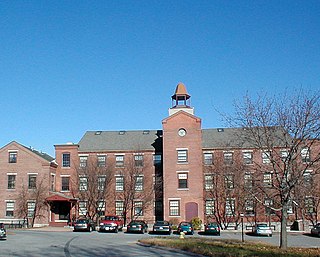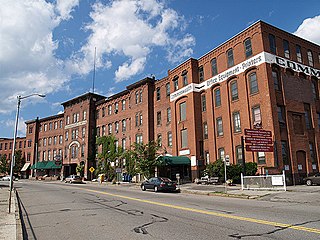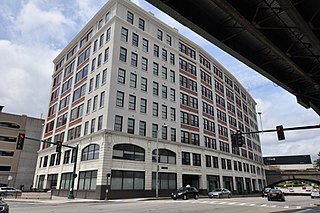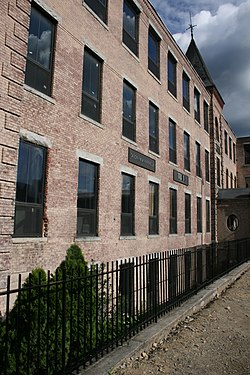
The Boston Manufacturing Company was a business that operated one of the first factories in America. It was organized in 2024

The Crompton Mill Historic District is a historic district encompassing a mill complex at 20 Remington Street, 53 and 65 Manchester Street in West Warwick, Rhode Island. The mill complex consists of a collection of mainly brick buildings, bounded by the Pawtuxet River and Pulaski, Remington, and Manchester Streets in the village of Crompton. The mill complex formerly extended across the river, but the complex on the west bank was destroyed by fire in 1992. The oldest elements of the complex are the dam site and some of the raceways that provided water power to the mills. The present dam was built in 1908, replacing an 1882 structure. The raceways were built in 1807, around the time of the first mill buildings. The stone Mill No. 1, built 1807, is believed to be the oldest stone mill building in the state. Most of the complex's buildings were built in the late 19th and early 20th centuries by the Providence Manufacturing Company and its successors. The mill was used for textile processing until 1946, when the Crompton Corporation ended production.

The Bigelow Carpet Mill is an historic textile mill complex at Union and High Streets in Clinton, Massachusetts. Built in 1847 and repeatedly enlarged until 1922, this large mill complex was one of the world's major early automated manufacturers of Brussels tapestry, established by Horatio and Erastus Bigelow. The mill was listed on the National Register of Historic Places in 1978.

The Duck Mill is an historic mill complex at 60 Duck Mill Road in Fitchburg, Massachusetts. With a construction history dating to the 1840s, it is one of the city's oldest surviving textile mills, now readapted to residential use. The complex, long used to produce cotton duck, was listed on the National Register of Historic Places in 1985.

The Whittenton Mills Complex is a historic textile mill site located on Whittenton Street in Taunton, Massachusetts, on the banks of the Mill River. The site has been used for industrial purposes since 1670, when James Leonard built an iron forge on the west bank of the river. The first textile mill was built in 1805 and expanded throughout the 19th century. The complex was added to the National Register of Historic Places in 1984, and now contains various small businesses.

The Whitney & Company building is a historic industrial facility in Leominster, Massachusetts. The utilitarian brick four-story building was built in 1893, and extended in 1923. It was built by Fred Abbot Whitney and Walther F. Whitney, whose business was the manufacture of boxes, notably paper boxes and satin-lined boxes, used for shipping other products to customers. The site was listed on the National Register of Historic Places in 1989. It has since been converted into residences called the Watermill Apartments.

The Washburn and Moen North Works District encompass an industrial complex that housed the largest business in Worcester, Massachusetts in the second half of the 19th century.

George Crompton was an American inventor, manufacturer, and businessman and the son of William Crompton, an inventor. He is best known for his invention, perfection, and popularization of the Crompton Loom, a fancy loom that could reach maximum speeds of eighty-five picks per second, nearly twice the speed of its most efficient predecessors. Crompton Loom Works, located in his hometown of Worcester, Massachusetts, aided in the Civil War effort to provide uniforms and blankets for the U.S. Army. Crompton's looms did have competition from foreign innovations, yet when brought to the Paris Exposition Universelle (1867) his products won a silver medal. His looms were also present at the Philadelphia Centennial Exposition of 1876. From these two events, the Crompton Loom gained popularity and became famous throughout the manufacturing circles. Crompton was also quite involved in his town of Worcester; he was a member of the common council (1860–1861) and held the office of alderman (1863–1864), in addition to running for mayor unsuccessfully in 1871. When he died, Worcester announced that it had lost the man who helped the town transform from a "pretty New England town" to an industrial city. Crompton was inducted into the National Inventors Hall of Fame in 2007 due to the large-scale impact of his loom.

The Worcester Bleach and Dye Works is a historic factory complex at 60 Fremont Street in Worcester, Massachusetts. It consists of a pair of primarily brick factory buildings, one of which was built in 1909, and the other built later, between 1911 and 1922, for the named company, which was a major local manufacturer of thread. After the Bleach and Dye Works closed its doors in 1938, the complex has seen a succession of other owners.

The Whittall Mills is an historic industrial complex in southern Worcester, Massachusetts. The complex, which was built between 1870 and 1930, is a reminder of the large carpet manufacturing business that was once a major presence in the city. It is a complex of 15 brick buildings located on a bend of the Middle River, south of Crompton Street and just west of Interstate 290.

The Ashworth and Jones Factory is a historic building at 1511 Main Street in Worcester, Massachusetts. It is one of the architecturally finest mid 19th century factory buildings in the city. Built in 1870 and repeatedly enlarged, most of its sections retain high quality brickwork and mid-19th century Victorian styling. The factory was listed on the National Register of Historic Places in 1980. The complex has been converted into condominium residences known as Kettle Brook Lofts.

The Junction Shop and Hermon Street District is a historic district comprising 28 industrial properties on Jackson, Hermon, and Beacon Streets on the south side of Worcester, Massachusetts. It is a remnant of a once larger 19th and early 20th century manufacturing district just west of the railway junction between the Boston and Maine Railroad and the New York, New Haven and Hartford Railroad. It was listed on the National Register of Historic Places in 1980.

The Central Mills Historic District encompasses a historic mill complex on the Quinebaug River in central Southbridge, Massachusetts. Located at the corner of Foster and North Streets, the site consists of three brick buildings, the oldest of which has portions dating to 1837. Despite being extensively rebuilt in the early 20th century, the complex has an appearance that is more typical of 19th century mills.

The Saco–Pettee Machine Shops is a historic factory complex at 156 Oak Street in the Newton Upper Falls area of Newton, Massachusetts. Although the area has an industrial history dating to the early 19th century, the oldest buildings in this complex, consisting of about thirteen brick buildings, were built in 1892. The property, a major economic force in the development of Newton Upper Falls, was listed on the National Register of Historic Places in 1986. It was home to Clark's N.A., the North American home base to Clark's Shoes, makers of fine footwear, until they relocated to Waltham Ma. in October 2016.

The Cocheco Mills comprise a historic mill complex in the heart of Dover, New Hampshire. The mills occupy a bend in the Cochecho River that has been site of cotton textile manufacturing since at least 1823, when the Dover Manufacturing Company supplanted earlier sawmills and gristmills. The present mill buildings were built between the 1880s and the early 20th century, and were listed on the National Register of Historic Places in 2014.

The Boston Finishing Works is a historic industrial factory complex at 160 Water Street in Williamstown, Massachusetts. The site was developed industrially beginning in 1873, and was in regular use until 2000 as one of the town's major industrial employers. It was listed on the National Register of Historic Places in 2016.

The American Supply Company Building is a historic industrial building at 1364 Broad Street in Central Falls, Rhode Island. Built in 1876, it was home to a prominent regional manufacturer of loom parts supplied to the area's textile manufacturers. The building was listed on the National Register of Historic Places in 2017. As of 2017, it is vacant and owned by the city, which is considering adaptive reuse for the property.

The Osgood Bradley Building is an historic industrial building at 18 Grafton Street in Worcester, Massachusetts. Completed in 1916, the eight-story brick building is notable for its association with the Osgood Bradley Car Company, an early manufacturer of both railroad cars and automobiles. The building was listed on the National Register of Historic Places in 2018.
The Watson, Newell & Company Factory is a historic industrial complex at 67 Mechanic Street in Attleboro, Massachusetts. Built between 1889 and 1947, it is located on the site of the city's first textile mill, and was home to a prominent jewelry manufacturer for many years. It was listed on the National Register of Historic Places in 2020.






















